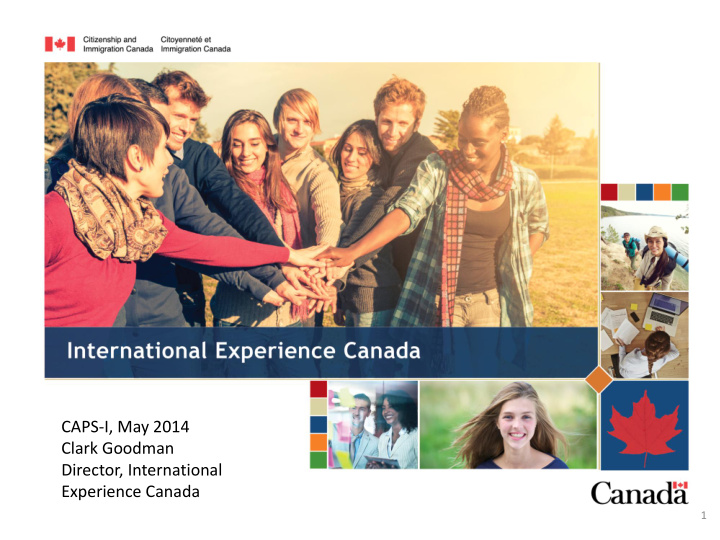



CAPS-I, May 2014 Clark Goodman Director, International Experience Canada 1
International Experience Canada : Why am I here? • IEC’s Goal: encourage Canadian youth to see the world. • Discussion and feedback: – How can we accomplish this goal? – What hurdles are we facing? – Potential partnerships 2
International Experience Canada: Background • The initiative originated in 1951 as a cultural exchange between Canada and Germany. • In the following years the program expanded to include, France and the United Kingdom. • Today: Canada has a youth mobility agreements (YMA) with 32 countries. • International Experience Canada (IEC) supports Canada’s economic and cultural interests by facilitating bilateral, reciprocal agreements with other countries to allow travel and work exchange opportunities for young Canadians and foreign nationals aged 18-35. 3
International Experience Canada: Background One Program. Three categories, thirty-two countries. • 97.5% of participants arrive through bilateral Youth Mobility Agreements (YMAs) negotiated with 32 countries. Work permitted depends on the IEC category. • Working Holiday (travel and work) – open work permits to allow work anywhere in the host country to supplement financial resources. • Young Professionals (career development) – employer-specific work permit to gain targeted experience within their profession or field of study. • International Co-operative Education (students only - internships) – employer-specific work permit to gain targeted experience within their field of study. Note: All three categories are not available in all 32 countries. Agreements are country specific. • 2014 global reciprocal quota is 68,500. 4
Canada has 32 youth mobility agreements Australia Greece Norway Austria Hong Kong Poland Belgium Ireland Slovakia Chile Italy Slovenia Costa Rica Japan Spain Croatia Republic of Sweden Korea Czech Republic Switzerland Latvia Denmark Taiwan Lithuania Estonia Ukraine Mexico France United Netherlands Kingdom Germany New Zealand 5
Reciprocal in Opportunity • YMA’s are reciprocal in opportunity. • Over the past decade, what was once a relatively reciprocal program has become quite unbalanced with only about 19,000 Canadians travelling and working abroad, compared to about 60,000 foreign nationals coming to Canada. • The numbers of Canadian’s going abroad has remained fairly consistent seeing only a slight decline in recent years. • This gap is a result of the program becoming much more popular among foreign youth wanting to come to Canada. • Current reciprocity gap: 3:1 6
International Experience Canada • Recently, the Temporary Foreign Worker (TFW) Program has come under a great deal of media scrutiny. • IEC accounts for roughly 25% of Temporary Foreign Workers to Canada • Many are concerned about the impact TFW’s have on the Canadian labour market. 7
2014 Reciprocal quota by category 6,142 (9%) Working Holiday Young Professional 6,778 International CO-OP (10%) 54,215 (81%) 8
Foreign youth coming to Canada • From the inbound perspective the program is wildly popular – Ireland: 3,850 places in 6 minutes – United Kingdom: 3,350 in 9 minutes – Spain: 810 places in 31 minutes – Germany: 2,100 places in 3 hours and 23 minutes 9
International Experience Canada: New Directions The three new key objectives of IEC are: 1. Prioritizing high-value bilateral relations and low-risk exchanges; 2. Facilitating high- quality participants that fit Canada’s immigration priorities; 3. Increasing reciprocity and enhancing international opportunities for young Canadians 10
Why aren’t youth going abroad? The four F’s FAMILY FINANCES FRIENDS FEAR 11
Engagement Strategy • Increasing reciprocity and Canadian participation levels is a major component of IEC’s renewed mandate. – Goal: increase reciprocity of the program to a target ratio of 2:1 by 2019 – This translates to a 50% increase in Canadian participation • IEC plans to accomplish this through further engagement with existing partners and the establishment of new partnerships with key stakeholders 12
Engagement Strategy • IEC has identified five sectors for engagement: 1. Academic Networks and IEC Alumni 2. Travel and Work 3. Canadian Private Sector 4. Other Government Departments, Provinces/Territories, and Foreign Governments 5. Diaspora and ethno-cultural communities 13
Engagement Strategy • By engaging existing and new partners, IEC aims to: – Increase awareness of the program as a primary facilitator of International Experience – Improve the number of quality employment opportunities available to Canadians abroad – Equip Canadians will the tools necessary to travel and work abroad – Reduce legislative and administrative barriers affecting Canadian Youth’s temporary migration to partner countries. 14
Partnerships Potential • Potential stakeholders in the academic community: CAPS-I ACCC CBIE AUCC • Partner with organizations that have complementary goals. • How can IEC and the members of CAPS-I work together to increase awareness of the IEC program? 15
Questions Discussion and Questions 16
Recommend
More recommend